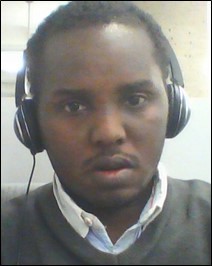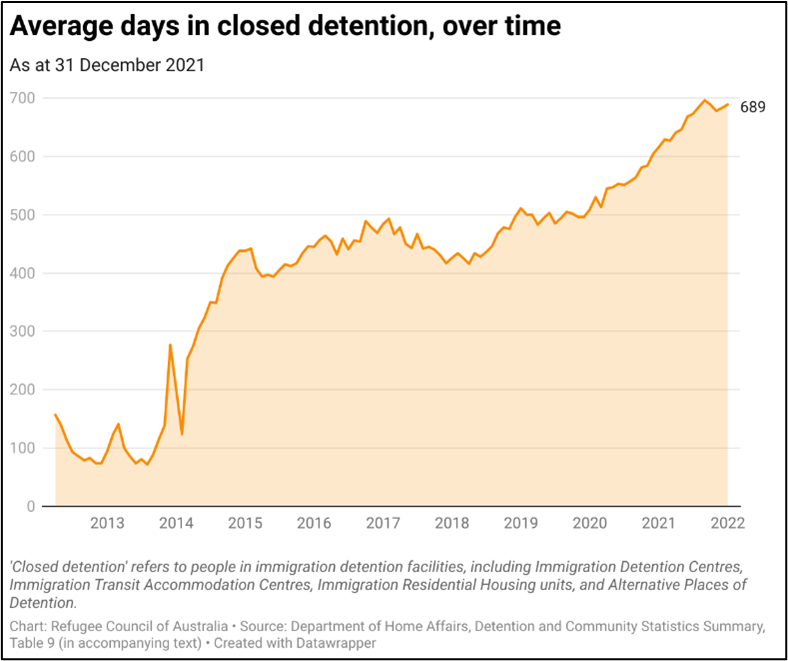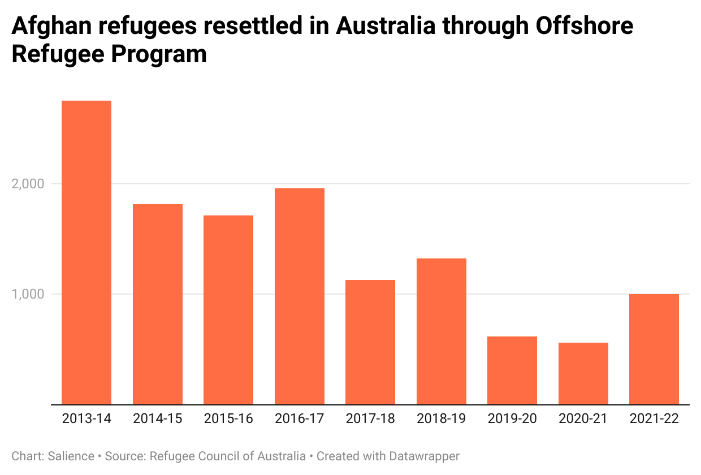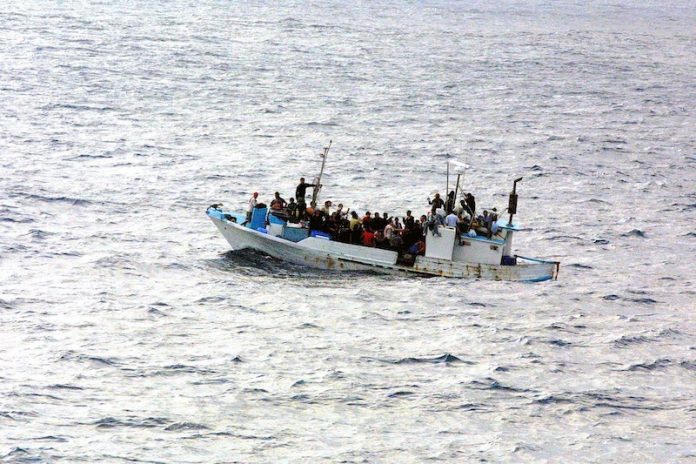Does Australia’s swift response in supporting Ukrainian refugees reveal a Eurocentric preference in our humanitarian program?
Bakhit had never seen the sea before that day; now he was surrounded by it. He and 30 other asylum seekers from Somalia, Sri Lanka, and his own native Sudan, sat close together in a small fisherman’s boat with a broken stabiliser arm, buffeted by squalls and the Indian Ocean swell.
 “It was so quiet,” Bakhit said.
“It was so quiet,” Bakhit said.
After two nights at sea, with one of the Sri Lankan refugees, an experienced fisherman piloting the boat, they were intercepted by an Australian Navy patrol boat and transferred to the immigration detention centre on Christmas Island. Bakhit, then 16 years old, was one of more than 20,000 asylum seekers to come to Australia by boat in 2013, still the largest number on record according to Australian Border Force reports.
The young teenager, a member of the Zaghawa tribe of Darfur subject to the genocide that claimed up to 300,000 lives, had fled Sudan a few weeks earlier. His parents and siblings had crossed the border into Chad when he was 11 years old. Bakhit was left behind in Sudan in the care of his uncle to continue his education, but an upsurge in government security forces violence targeted at ethnic groups in 2013 led Bakhit to flee with two friends of his eldest brother. They took flights to Yemen, then Jakarta, followed by a nine-hour drive to an isolated beach on the south coast of Java. Then Bakhit handed over his mobile phone and passport to the people smugglers and stepped onto a boat for the first time in his life.
After three months of processing through detention centres in Christmas Island, Darwin and Hobart, Bakhit was released into the community on a bridging visa. He was transferred to Sydney where he lived in public housing with other refugees. “It was good to get out into the community,” he said. “It was a relief.”
Soon afterwards Bakhit was moved to a Safe Haven Enterprise visa (SHEV), a new visa the incoming Abbot government introduced for the legacy caseload of 30,000 refugees who had arrived by boat between 2009 and 2013. The SHEV visa has a requirement to work or study in designated regional areas of Australia for 3½ years without receiving welfare payments. The visa must be renewed every five years, without any guaranteed pathway to a permanent visa.
“It’s quite confusing. I don’t understand it because it’s a requirement for someone to work in rural areas,” said Bakhit. “But the outcome is not guaranteed. Not many refugees are able to fulfil the requirement because it’s quite difficult; it requires a lot of sacrifices.”
A Department of Home Affairs report reveals that 13,813 SHEV visas have been granted as of May 2022. The ABC’s 7.30 reported on March 30 that out of that number only one refugee has transitioned to a permanent visa.
As required, Bakhit is now living in Mittagong in the Southern Highlands and working in an aged care home. He is supported by Rural Australians for Refugees, a network of volunteers assisting refugees to settle in regional areas. Memories of his own experiences flood back when he sees images in the media of refugees in other parts of the world.
“What happened in Afghanistan was terrible, and also what is happening in Ukraine,” he said. “Whenever you see people fleeing, you are a part of that. It will remind you again of that danger.”
—————————————————————————————————-
What most defines the fate of Bakhit and other refugees from countries like Sudan, Iran and Afghanistan is the simple matter of time. Had Bakhit arrived on Australian shores a few months later he would have been subject to the mandatory offshore processing the Government announced in July 2013. Immigration authorities sent the first boatload of refugees to Manus Island under this arrangement in October.
Asylum seekers arriving from most countries since then have been bouncing around the system for much longer than Bakhit experienced. The average length of detention for all detainees across the Australian immigration network has recently increased to 689 days, the longest on record. As of January 2022, 124 people have been detained in immigration detention facilities for five years or more according to Australian Border Force reports.
The time Australia keeps refugees in its system is long by the standards of western democracies. The average length of detention in Canada, the United States and the United Kingdom is 14, 55, and 29 days respectively. Human Rights Watch Australia made this unfavourable comparison when referring to Australia’s detention policies as “inhumane” in a submission to the Ending Indefinite and Arbitrary Immigration Detention Bill that Independent senator Andrew Wilkie tabled in February 2021. The Bill made no progress through parliament, hand-balled between various Standing Committees before the Government was dissolved for the May election.

Yet, in 2022, a new group of refugees arrived and found themselves guided smoothly into the system. Since February, the Australian Government has granted 6000 visas to Ukrainians fleeing the Russian invasion. According to a Department of Home Affairs statement, 1700 Ukrainians have arrived as of April 6.
Ukrainian refugees are entering Australia on a tourist visa with a pathway to a 3-year Temporary Protection Visa (TPV). In a media release on March 11 this year, Immigration Minister Alex Hawke flagged the possibility that the pathway for Ukrainians could extend to permanent settlement. And in a press conference on February 23, then Prime Minister Scott Morrison announced that Ukrainian visa applications would be “top of the pile”.
The Ukraine Council of NSW (UCNSW) has been closely involved with the Australian Government in developing the visa solution and supporting Ukrainian refugees on their arrival. UCNSW Vice President Andrew Mencinsky expressed his appreciation of the Government’s response. “The fact the Australian Government made it relatively simple initially was very gratefully received,” he said.
Volunteers shoulder the burden in settling refugees, including maintaining a database for matching new arrivals with available accommodation in the Ukrainian community. As the Ukrainians move on to the TPVs, the government-funded refugee settlement service, Settlement Services International (SSI), provides some relief and support.
“Initially there was too much being put on the shoulders of volunteers,” said Mencinsky. “I think the community’s very glad now that settlement providers can come in. Is the Government doing enough? It’s probably a bit too soon to tell because we don’t know yet what the Government will do or how effectively they will do it. All first impressions of SSI are very positive.”
The UNHCR estimates that 500,000 Afghan refugees have fled the Taliban regime in the latest refugee crisis, adding to the 2.6 million registered Afghan refugees worldwide. In response, the Australian Government has increased the number of places available to Afghans in the Humanitarian and Migration Program to 31,500 over the next four years. Immigration officials informed a Senate committee hearing in February that they had received 55,000 applications, with 1000 visas granted through the Offshore Refugee Program as of that date.
Several organisations, including the Australian Christian Lobby and the Australian Greens, have accused the government of double-standards in processing visas for Afghans more slowly than for Ukrainians.
“By ‘go to the top of the pile’, what does this say in regards to those fleeing the horrors of the Taliban in Afghanistan?” an ACL spokesperson told Guardian Australia on March 3. “We don’t need a pile. We can continue to offer shelter to those fleeing the humanitarian crisis in Afghanistan, as well as processing visa applications swiftly from Ukraine citizens.”
On the same day, Afghan refugee and refugee advocate Najeeba Wazefadost posed the following question in an episode of the ABC’s Q&A broadcast.
“If we put the Ukrainian refugees in detention centres today, how would everyone in the room react to that?,” she said. “And right now in Australia, we have hundreds of asylum seekers that are in detention centres.”

————————————————————————————————
Others are more blunt in their critiques. Ian Rintoul, spokesperson for the Refugee Action Coalition (RAC), sees a system very much weighted on the basis of race.
“I think there is a very stark contrast between the Government’s attitude to refugees from Ukraine and almost anywhere else in the world,” he said. “It’s impossible not to draw the conclusion that there is an exception being made for the Ukrainians because they look like the kind of people the Government likes to have here, compared to people from Asia and other places who are Muslim, who are brown or black.”
Rintoul does not object to Ukrainians being welcomed into the country as they seek refuge from the Russian invasion. In his view, that welcome should be extended to all refugees.
“We think it’s great that the Government has a much more open-door attitude to refugees from Ukraine,” he said. “But if there’s going to be a genuine refugee policy, the door needs to be open to all refugees, no matter where they’re coming from. As terrible as the circumstances for Ukrainian refugees are, you only need to look at the circumstances for people such as the Rohingya who are suffering a genuine genocide. They’ve not seen the same welcoming attitude from the Government.”
Mencinsky of UCNSW acknowledges that the response to Ukrainian refugees is different to that extended to refugees from other countries. He explains this is due to a cultural memory of twentieth century wars in Europe.
“I would hope it’s not on the basis of subconscious white racism, or white affinity,” he said. “I think it’s probably more of a connection Australians have to Europe. It is part of our collective memory. War in Europe is a great catastrophe; it is one of the worst things that can happen. And when [Australians] see a war in Europe, suddenly it stirs that [memory].”
Louise Redmond is National President of Rural Australians for Refugees (RAR), the volunteer network supporting Bakhit. RAR volunteers are sponsoring more than 70 Afghan refugees to enter Australia. All these refugees assisted the United Nations and coalition forces before the withdrawal and fear persecution from the Taliban regime.
Redmond speaks of a former soldier who had been trained by Norwegian special forces. “We’ve managed to get that guy out of Afghanistan,” she said. “He was living in the mountains in total fear of his life.”
In May this year, the government had just begun processing visa application sponsors submitted in September 2021. Sponsors have only recently received file numbers for the applications submitted in August.
“We just sit back in amazement when we see how Ukrainians are being welcomed in,” Redmond said. “But processing of the visa applications that are in for Afghans is going very, very slowly.”
Sponsors have questioned their local Members of Parliament about the delays in processing claims for asylum from Afghan refugees in comparison with Ukrainians. Redmond says MPs frequently cite security considerations as the main difference between the two groups.
“They say, ‘Oh, you can’t be too careful, you have to really scrutinise people coming from Afghanistan very, very carefully, as opposed to somebody coming from Ukraine. They could be terrorists’,” she said. “They’re just people terrified for their lives who want to keep their families safe.”
Jasmina Bajraktarevic-Hayward is the first refugee to be president of the Refugee Council of Australia (RCA), having come to Australia as a refugee from Bosnia-Herzegovina in 1993. She does not agree with the claim that the Government is favouring Ukrainian refugees.
“The bureaucratic process of getting visas and having entitlements is quite challenging. There have been some very confused people who are largely receiving support from [the] Ukrainian community as opposed to service providers. Accommodation, financial assistance, and Ukrainian doctors are seeing people for free. Money is coming from the Ukrainian community in general rather than our Government providing support.”
Bajraktarevic-Hayward acknowledges the contrast with the delays refugees from other countries experience, but sees greater injustice in the government’s view that Sri Lanka is safe for ethnic minorities. Asylum seekers from Sri Lanka bear the burden of proof in demonstrating the need for protection. UK courts and the Australian Centre for International Justice challenged Australia’s stance in a submission to DFAT in October 2020.
“Nobody considers Afghanistan safe,” she said. “But officially Sri Lanka is considered safe so many asylum seekers might not even be able to obtain a TPV.”
The Australian Human Rights Commission is developing a National Anti-Racism Framework for guiding anti-racism actions throughout the community. But Bajraktarevic-Hayward says declining funding for the AHRC announced in the March Federal Budget will hamper the Framework’s progress. According to Government Budget statements, AHRC funding will decline by 38 per cent over the next four years.
“They will write a report and basically it will stop there,” she said. “That Anti-Racism framework will have to look at things like systemic racism in all Government service provisions, but it’s got no money to continue.”
—————————————————————————————————–
For Bakhit, the memories and trauma that resurface when viewing Afghan and Ukrainian refugees fleeing their homelands speak to the need for a universal and humanitarian response to all refugees, regardless of race or country of origin.
“For me, I see every person who is a refugee is looking for their safety,” he said. “It doesn’t matter which colour or race, every person should get support, get a fair chance. I believe that every person who is a refugee, and fleeing for their safety, should get support.”


